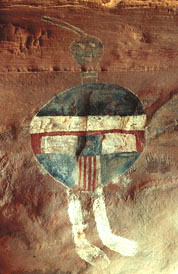|
Radiocarbon Dates on the All American Man Pictograph by S. D. Chaffee, M. Hyman, M. Rowe, N. Coullam, A. Schreodl, K. Hogue. 1994. American Antiquity 59(4):769-781.
Two small, well conserved tabular sandstone masonry structures of Puebloan origin are in the alcove. A small storage structure may have been present, as well as an artificial floor below the pictograph. Smoke blackens the ceiling. Archaeological evidence, particularly ceramics, indicates a late Pueblo II-Pueblo III site. Small flakes of exfoliated, blue paint were found at the site. Optical microscopic examination determined the microstratigraphy of the samples and that the flakes were free of modern contamination. Dating is only attempted when no overpainting is evidenced. A white layer was noticed under the paint. Using scanning electron microscopy (SEM) a natural calcium and sulfur surface accretion due to fluid migration in the rock substrate was found. After plasma extraction of the carbon X-ray diffraction (XRD) was employed to determine mineral composition of the natural surface mineral accumulations. The XRD confirmed the SEM results. The spectrum revealed quartz from the sandstone and calcium sulfate and a calcium oxalate derived from gypsum. The carbon extraction methodology is discussed. A radiofrequency (RF) generated low temperature, low pressure oxygen plasma is used to separate carbon from the pigment by oxidation to carbon dioxide. The conditions are sufficiently mild such that the selective removal of the organic phase occurs. In the plasma system a high vacuum prevents contamination by atmospheric carbon dioxide. Less than 1 millitorr of carbon dioxide is tolerated. Before the sample introduction, after five hours of pressure observation, an argon plasma produced only 0.0007 mg of carbon. Total modern carbon contamination of the sample is calculated at < 1.4 percent. A 1.06 gram sample of rock and pigment was thoroughly degassed. A cooper oxide furnace heated to 900.C introduced pure oxygen. With oxygen pressure at 1.0 torr liquid nitrogen was introduced and the RF generator produced a plasma for an hour. About 280 millitorr of carbon dioxide was produced. A second treatment produced 130 millitorr after 3 hours. The amount of carbon is calculated from the number of moles of carbon dioxide. The samples were sent to the National Science Foundation-University of Arizona Accelerator Mass Spectrometry Laboratory. A 4.5 hour third treatment produced insufficient carbon for accurate radioactive analysis. Treatment results are summarized in Table 1 of the article. Previous tests demonstrated no decomposition of natural, fully oxidized carbonates in rock substrates at the operation level of 100 watts of RF plasma power, as illustrated in Figure 8. The methodology is therefore applicable to limestone substrates. No radioactive carbon contamination from magnesium carbonates, calcite or from gypsum derived calcium oxalate accretions on sandstone should occur at 100 watts of power. Results discussion follows the methodology presentation. The Arizona AMS sample results are presented in Table 2. The first sample is dated as 175 years older than the second. The first sample may have contained all carbon from the charcoal fraction in the paint, and the second sample carbon from organic binders. A problem in archaeological dating of charcoal is that the charcoal can be "old wood." The authors conclude that "the best estimate of the age of the All American Man pictograph is the weighted average of 676 ±46 years BP." The antiquity of the blue paint was confirmed. This does not preclude historic alteration of the red and white portions of the pictograph. The National Park Service's conservation policy only allowed dating of naturally exfoliated samples. The ± AD 1295 date closely matches a ± AD 1284 date obtained from nearby Ceremonial Cave, in the Escalante drainage across the Colorado River from the All American Man. The authors speculate on the implications of these findings with reference to cultural affiliation, directions of cultural influence, diffusion and migration, and modern rock art typology. The dates correspond to the Great Drought when an estimated 30,000 people migrated from the region. Salt Creek has a significant, reliable spring with heavy flow. The authors end with the conclusion that dating techniques such as those employed in their study can be used to test hypothesis about migrations, cultural diffusion and style distribution. Top of Page ----- References Cited |
 A
very unique pictograph on Upper Salt Creek of
A
very unique pictograph on Upper Salt Creek of 